Research Article - Volume 3 - Issue 5
Zoo animal health and conservation; A case study of traumatic VentriculoPeritonitis in African ostriches (Struthio Camelus)
Jallailudeen Rabana Lawal1*; Umar Isa Ibrahim1; Shehu Usman Hassan2
1Department of Veterinary Medicine, Faculty of Veterinary Medicine, University of Maiduguri, P.M.B 1069, Maiduguri, Borno State,Nigeria.
2Department of Veterinary Pathology, Faculty of Veterinary Medicine, University of Maiduguri, P.M.B 1069, Maiduguri, Borno State,Nigeria.
Received Date : Sep 06, 2023
Accepted Date : Sep 30, 2023
Published Date: Oct 11, 2023
Copyright: © Jallailudeen Rabana Lawal
*Corresponding Author : Jallailudeen Rabana Lawal, Department of Veterinary Medicine, Faculty of Veterinary Medicine, University of Maiduguri, P.M.B 1069, Maiduguri, Borno State, Nigeria.
Email: rabanajallailudeen@yahoo.com
DOI: Doi.org/10.55920/2771-019X/1565
Abstract
This case report examines a severe case of traumatic ventriculo-peritonitis in African ostriches within University of Maiduguri zoological garden setting. It provides a comprehensive analysis of the clinical presentation, diagnostic procedures, and post-mortem findings. The ostriches involved, one female and one male (each 5 years old), were part of a breeding program aimed at contributing to the preservation of this endangered species. During the routine health checks, the male ostrich was observed to be lethargic, anorexic, and displaying abdominal distension. Physical examination revealed severe abdominal discomfort, tachycardia, and tachypnea. Diagnostic imaging, including radiographs and ultrasonography, showed the presence of free fluid in the coelomic cavity. The patient was scheduled for surgery but, unfortunately, died the night before the procedure. A detailed necropsy and further analysis were conducted to determine the exact cause of death and to refine future diagnostic and treatment protocols for the benefit of the zoo's animal population. The bird carcass was highly dehydrated and emaciated. Post-mortem examination further revealed extensive peritonitis, with adhesion of the ventriculus and some part of the proventriculus to the left thoracoabdominal wall, as well as complete depletion of the coronary fat of the heart. Additionally, the presence of polythene bags, gravel, sticks and wires that had perforated the ventriculus resulting in peritonitis. Histopathology confirmed acute fibrinous peritonitis with suppurative inflammation in the coelomic cavity, consistent with the diagnosis of traumatic ventriculo-peritonitis. It was later discovered that the predisposing factors were ingestion of metallic objects and other non-digestible materials by residents of the Dalori IDP camp. Addressing this issue is imperative to ensure the health and well-being of the zoo's captive animals and to uphold its mission of conservation and education. By engaging the community, improving waste management, enhancing security, and raising public awareness, we can collectively safeguard this precious asset for future generations.
Key words: African ostrich, Necropsy, Traumatic, Ventriculo-peritonitis, Zoological garden.
Introduction
Zoological gardens play a vital role in the conservation of endangered species and provide an opportunity for the public to connect with wildlife (Fukano et al., 2020; Spooner et al., 2023). The well-being of animals in these settings is paramount, and veterinary care is central to achieving conservation goals (Tallo-Parra et al., 2023).
The concept of zoos has always been a subject of controversy, with various concerns raised by researchers (Maynard, 2018). Some argue that animals can seem to be controlled and confined for human benefit, rather than their own welfare (Normando et al., 2018). Additionally, interactions with visitors may not always serve the best interests of the animals (Arumugam et al., 2020). Furthermore, the conservation goals of zoos are sometimes not fully realized due to the presence of animals (Vasconcellos et al., 2016).
Certain species may not thrive in captivity due to specific aspects of their natural history, and the stress responses of captive animals can differ from those in the wild, especially when they cannot avoid human presence (Rose and Riley, 2022). Differences in environmental conditions between captivity and the wild can lead to long-term health issues and reduced lifespans for animals in captivity (Potter and Clauss, 2005).
To justify the positive aspects of zoos, it is crucial for them to continually improve their care and management practices, tailoring them to the specific needs of each species (Clay and Visseren-Hamakers, 2022). Additionally, ongoing assessments of the individual needs of the animals within these species are essential.
The University of Maiduguri Zoological Garden is a captivating destination for nature enthusiasts and animal lovers in Maiduguri, Nigeria. This tranquil sanctuary within the university campus houses a diverse range wildlife species from both local and international origins. Visitors to the zoo will have the opportunity to encounter a selection of captivating animals, including indigenous species like African freshwater Crocodiles, Horses, Gazelle monkeys, snakes and various bird species. These animals are carefully curated and housed within spacious enclosures that mimic their natural habitats, allowing them to thrive in a secure and comfortable environment.
The management of the University of Maiduguri Zoological Garden is committed to the well-being and welfare of its animal residents. They place a strong emphasis on providing appropriate nutrition, medical care, and environmental enrichment. Animals are fed diet, tailored to their specific dietary needs, and are closely monitored by experienced caretakers and veterinarians. Additionally, the zoo's management team ensures that the enclosures are designed with the animals' welfare in mind, incorporating features that encourage natural behaviors and mental stimulation.
Although significant efforts are made to ensure the well-being of animals in captivity, they can still face health problems due to ingesting materials that are harmful or indigestible, potentially leading to conditions like impactions or peritonitis.
Traumatic ventriculo-peritonitis (Hardware disease) develops as a consequence of perforation of the ventriculus in birds by sharp metallic objects. Generally, traumatic peritonitis is most common in mature large ruminants (cattle) and avian species such as the Ostriches, turkeys and even chickens and rarely reported in other avian species (Ramanan et al., 2021; Adam et al., 2022).
Ostriches commonly ingest foreign objects, because they do not discriminate against metallic materials in their feed or environment. They tend to swallow any object they can grab with their beak (Irfan et al., 2020). Swallowed metallic objects, such as nails or pieces of wire, fall directly into the gastrointestinal tract and are subsequently carried over to the ventriculus (Adam et al., 2022). Contractions of the venticulus may promote penetration of the wall by any swallowed sharp edged metallic objects. Perforation of the wall of the venticulus allows leakage of ingesta and bacteria, which contaminates the peritoneal cavity. The resulting peritonitis is generally localized and frequently results in adhesions (Ogbe et al., 2016).
This case report centers on a traumatic ventriculo-peritonitis case in African ostriches at University of Maiduguri Zoological garden, Maiduguri, Nigeria, emphasizing the importance of comprehensive healthcare in zoo settings.
Case Presentation
Clinical History:
Two African ostriches (Struthio camelus) were housed together in a large enclosure at University of Maiduguri, Zoological garden, Maiduguri, Nigeria. The ostriches, one female and one male (each 5 years old), were part of a breeding program aimed at contributing to the preservation of this endangered species.
The veterinary team has been alerted to one of the ostriches deteriorating condition, prompting a rapid response from the zoo’s medical professionals for emergency intervention. On routine health checks, the male ostrich was observed to be lethargic, anorexic, and displaying abdominal distension. Physical examination revealed severe abdominal discomfort, tachycardia, and tachypnea. Diagnostic imaging, including radiographs and ultrasonography, showed the presence of free fluid in the coelomic cavity.
Diagnostic Procedures:
Upon presentation, the following diagnostic procedures were performed:
- Radiography: Abdominal radiographs confirmed the presence of free air within the coelomic cavity, indicative of an intracoelomic air sac rupture.
- Ultrasonography: Ultrasonography revealed moderate to severe coelomic effusion and fibrin deposits within the abdominal cavity.
- Blood Analysis: Hematological and biochemical profiles showed leukocytosis and elevated serum protein levels.
Based on these findings, a diagnosis of traumatic ventriculo-peritonitis was made, likely resulting from a foreign body ingestion leading to the rupture of the proventriculus or gizzard. Recognizing the severity of the ostrich’s condition, a rapid response team of experienced veterinary doctors and technicians was assembled to visit the zoological garden for an emergency intervention. The team after assessing the ostrich’s condition plan for surgery. Tragically, the ostrich passed away unexpectedly on the night before the scheduled surgery date. Despite the best effort of the veterinary team and the use of advanced medical interventions, the ostrich’s condition deteriorated rapidly, leading to its unfortunate demise.
A detailed necropsy and further analysis was conducted to determine the exact cause of death and to refine future diagnostic and treatment protocols for the benefit of the zoo's animal population.
Necropsy Procedure Description:
To prepare the ostrich for necropsy, the body was moistened with water to facilitate the examination, particularly for the presence of external parasites and to prevent feathers from becoming airborne. Subsequently, the ostrich was positioned on a necropsy table in a dorsal recumbent posture.
The process involved sequentially handling each leg of the ostrich, extending them away from the body, and making incisions in the skin between the legs and the abdomen on both sides. Afterward, both legs were firmly grasped at the femur area and gently bent forward, downward, and outward until the femurs were detached from their acetabular attachments. This maneuver allowed the legs to lay flat on the table.
Further incisions were made in the skin, between the keel and vent area, followed by carefully reflecting the cut edge forward to expose the neck. A transverse incision was made midway between the keel and vent, proceeding through the breast muscles on each side. The rib cage, along with the coracoid bones and clavicles on both sides, were severed using a bone cutter. Finally, the sternum was opened, and the visceral structures attached to it were extracted from the abdominal cavity for a detailed gross examination."
Top of Form
Post-Mortem Findings:
Bird carcass highly dehydrated and emaciated with scaling of the body. Post-mortem examination revealed extensive peritonitis, indicating the severity of the condition. Adhesion of the ventriculus and some part of the proventriculus to the left thoracoabdominal wall. Complete depletion of the coronary fats of the heart. Presence of polythene bags, gravels, sticks and some wires that have perforated the ventriculus resulting in peritonitis. Locally extensive dark-red areas and patchy pale areas were seen on the liver. Histopathology confirmed acute fibrinous peritonitis with suppurative inflammation in the coelomic cavity, consistent with the diagnosis of traumatic ventriculo-peritonitis.
Protocol for Histopathological Examination:
After a 48-hour period, the preserved gizzard tissue sections were sliced into 2-3 mm thick pieces and subjected to dehydration using various concentration of alcohol (70%, 80%, 90% and 100%) for 15 minutes each. Following this, they underwent a clearing process in xylene before being embedded in paraffin wax. Subsequently, sections with a thickness of 4-5 microns were cut and subjected to staining using the hematoxylin and eosin method, as described by Jensen (2008) and Alwahaibi et al. (2015). Finally, the stained slides were examined at magnification of x4, x10, and x100 under a standard light microscope to detete the presence of characteristic or suggestive lesions.
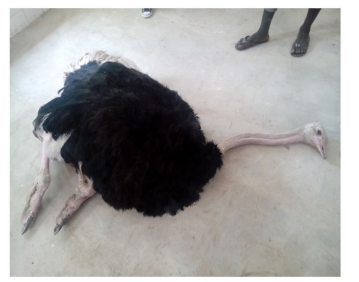
Figure 1: The Ostrich carcass before necropsy
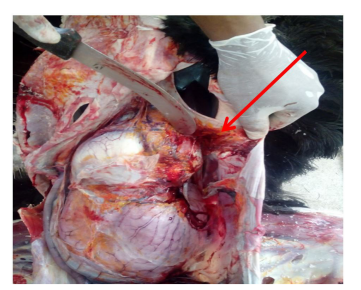
Figure 2: Adhension (red arrow) of the Ventriculus and Proventriculus to the left thoracoabdominal wall
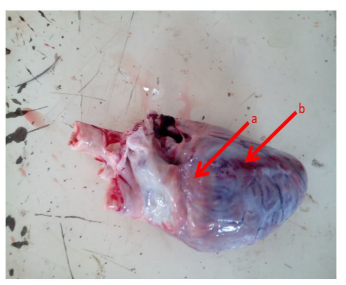
Figure 3: The heart showing (a) absence of coronary fat with (b) focal red patches on the epicardium
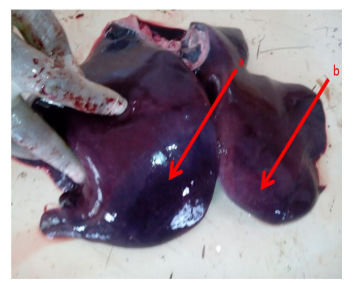
Figure 4: Liver showing a locally extensive dark-red area and multi-focal area of necrosis
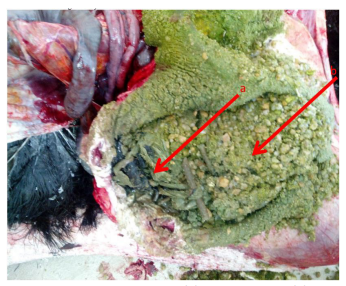
Figure 5: Ventriculus containing (a) polythene bags, (b) sticks and gravels (red arrows)
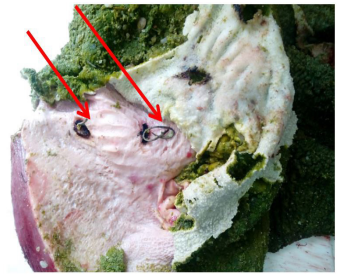
Figure 6: Ventriculus showing areas of perforation by wires (red arrows)

Figure 7: Perforating wires (bean and S- shaped) after removal suggestive lesions.
Discussion
The Ostrich: The world Largest Living Bird:
The ostrich, known as the world's largest living bird, weight exceeding 150 kg (330 pounds), an adult male may be 2.75 metres (about 9 feet) tall, the female is somewhat smaller. The male is mostly black but has white plumes in the wings and tail; females are mostly brown. The head and most of the neck, reddish to bluish in colour, is lightly downed; the legs, including the powerful thighs, are bare. The head is small, the bill short and rather wide; the big brown eyes have thick black lash (Britannica, 2023). This remarkable avian species belongs to the Struthionidae family and is classified under the genus Struthio (Cooper, 2000; Mikhailov and Zelenkov, 2020). The ostrich's distinctive dome-shaped back, its adaptation to arid desert habitats, and its peculiar, camel-like feet have led to its species name, camelus. Currently, four distinct subspecies are acknowledged, each inhabiting different regions of the African continent: the northern savannah (Struthio camelus camelus), eastern savannah (Struthio camelus massaicus and Struthio camelus molybdophanes), and southern savannah (Struthio camelus australis). Notably, a hybridized version of the ostrich, resulting from a mix of Struthio camelus australis, Struthio camelus massaicus, and Struthio camelus syriacus, is commonly referred to as the 'African black' or 'domestic' ostrich (Verwoerd, 2000). These flightless birds are among the largest ground-dwelling avians and are part of a group that includes rheas, emus, kiwis, and cassowaries (Cooper, 2000; Mikhailov and Zelenkov, 2020).
Challenges Faced by the University of Maiduguri Zoological Garden: Impact of Waste Disposal from Dalori IDP Camp:
The University of Maiduguri Zoological Garden serves as a crucial institution for education, research, and conservation in Borno State, Nigeria. Its primary mission is to conserve and protect local wildlife, facilitate research, and educate the public about the region's diverse fauna. The zoo houses a wide variety of animals, including native species, and serves as an invaluable resource for both local and international visitors. The zoological garden is situated in the Dalori Area, along the Maiduguri to Bama road. This zoological garden is located adjacent to Dalori’s Internally Displace Persons (IDP) camp. Unfortunately, despite its noble objectives, the zoological garden faces a dire challenge – the residents of the camp often dispose of their household waste by throwing it over the boundary wall into the zoological garden premises. This behavior, driven by the lack of proper waste management infrastructure within the camp, poses a severe threat to the well-being of the captive animals within the zoo, as it exposes them to the ingestion of indigestible materials and other foreign objects that could be harmful to their health.
In large animals and captive ratites, the ingestion of foreign objects is a fairly common occurrence. Specifically, metallic foreign items like nails, wire, screws, and similar items can result in a condition known as hardware disease (Ogbe et al., 2016; Devi-Prasad et al., 2017). This is especially prevalent in captive settings where construction work has taken place within the enclosures or when materials are introduced along with leaf litter or other substrates. The powerful contractions of the gizzard muscles have the capacity to push sharp objects through the muscular wall (Smith, 2020; Adam et al., 2022). This leads to a decrease in ventricular contraction, insufficient food digestion, and the development of colic.
Typically, these foreign objects may penetrate the proventricular wall, resulting in either an acute, widespread purulent peritonitis or a localized peritonitis with the formation of abscesses on the surface of the proventriculus, gizzard, or duodenum, (Smith, 2020; Adam et al., 2022). The resulting colic can trigger self-harm behaviors such as kicking and scratching, leading to lacerations and hemorrhages observed on the Ostrich's body as described in this Case Report
Importance of Zoological Gardens in Conservation:
Zoological gardens serve as critical conservation hubs for endangered species, providing a controlled environment for breeding programs and research initiatives. African ostriches, listed as vulnerable by the IUCN, are no exception (Adekola and Tunde-Ajayi, 2015; Ofuya et al., 2016). The loss of the male ostrich in this case underscores the significance of these institutions in maintaining genetic diversity within captive populations and ultimately contributing to the preservation of species threatened in the wild.
Veterinary Care in Zoological Gardens:
Veterinary care in zoological settings is multifaceted and demands a comprehensive approach. It includes routine health assessments, disease prevention, and the management of emergent medical cases, such as traumatic ventriculo-peritonitis. The expertise of zoo veterinarians is crucial not only in diagnosing and treating individual animals but also in advancing scientific knowledge that benefits both captive and wild populations (Fesseha et al., 2022).
Traumatic Ventriculo-peritonitis in Ostriches:
Traumatic ventriculo-peritonitis is a common and life-threatening condition in ostriches. The predisposition of these birds to ingest foreign bodies due to their indiscriminate feeding habits makes them susceptible to such trauma. Prompt diagnosis and intervention are vital, as was the case here, even though the outcome was unfavorable. Similar cases has been reported from Abuja (Ogbe et al., 2016) and Ilorin (Adam et al., 2022) in Nigeria.
Conclusion
The University of Maiduguri Zoological Garden, a symbol of biodiversity conservation and education, faces a significant threat from the irresponsible disposal of waste mix of non-biodegradable materials, such as plastics, glass, and metals, along with organic waste by Dalori IDP camp residents. Detailed necropsy findings have revealed that traumatic ventriculo-peritonitis was the primary cause of death in male African ostrich at the University of Maiduguri’s zoological garden. This condition is believed to have resulted from the ingestion of metallic and non-digestible materials originating from leftover construction materials and domestic waste disposed of over the wall of Dalori’s IDP camp bordering the zoological garden.
This case report also highlights the importance of effective veterinary care in zoological gardens for the conservation of endangered species, specifically African ostriches. Traumatic ventriculo-peritonitis serves as a poignant example of the challenges faced in managing the health of these animals. As zoological institutions continue their crucial work in species conservation, a proactive and multidisciplinary approach to veterinary medicine remains essential for the well-being and survival of the animals in their care.
Addressing this issue is imperative to ensure the health and well-being of the zoo's captive animals and to uphold its mission of conservation and education. By engaging the community, improving waste management, enhancing security, and raising public awareness, we can collectively safeguard this precious asset for future generations.
Conflict of interests
The authors declare that there is no conflict of interest in publishing this work.
References
- Adam, M., Ajadi, A. A., Atata, J. A. and Akanbi, O. B. (2022). Traumatic Ventriculitis in an African Ostrich: A Case Report. Media Kedokteran Hewan, 33 (1): 48-52. DOI: 10.20473/mkh.v33i1.2022.48-52
- Adekola, B. O. and Tunde-Ajayi, O. (2015). Contributions of Zoological Gardens to Wildlife Conservation: Case Study of University of Ibadan and Obafemi Awolowo University Zoos. Conference: Organization for Women in Science for the Developing World "Role of Women in Science for World Security" At: 2nd International Conference and Exhibition Owsd - Federal University of Technology Akure 2015. 2nd International Conference and Exhibition (OWSD-FUTA), November 1- 4, 2015, 516-522.
- Alwahaibi, N. Y., Alkhatri, A. S. and Kumar, J. S. (2015). Hematoxylin and eosin stain shows a high sensitivity but sub-optimal specificity in demonstrating iron pigment in liver biopsies. International Journal of Applied and Basic Medical Research, 5(3): 169-171. doi: 10.4103/2229-516X.165365
- Arumugam, K. A., Top, M. M., Ibrahim, W. N. W., Buesching, C. D. and Annavi, G. (2020). Social and reproductive behavior of captive Malayan tapirs’ (Tapirus indicus): interactions with maternal experience and environmental conditions. Scientific reports, 10(1): 4117. doi: 10.1038/s41598-020-60429-0
- Britannica, T. (2023). Editors of Encyclopaedia (2023, August 4). ostrich. Encyclopedia Britannica. https://www.britannica.com/animal/ostrich
- Clay, A. S. and Visseren-Hamakers, I. J. (2022). Individuals matter: dilemmas and solutions in conservation and animal welfare practices in zoos. Animals, 12:398. doi: 10.3390/ani12030398
- Cooper, R. G. (2000). Critical factors in ostrich (Struthio camelus australis) production: a focus on southern Africa. World's Poultry Science Journal, 56(3): 248-265.
- Devi-Prasad, V., Ravi-Kumar, P., Harikrishna, N. V. V. and Bhagyaraju, D. (2017). Traumatic reticulitis, reticulo-peritonitis and pericarditis (Foreign body syndrome) in bovines Journal of Livestock Science, 8: 98-102.
- Fesseha, H., Kefelegn, T. and Mathewos, M. (2022). Animal care professionals' practice towards zoonotic disease management and infection control practice in selected districts of Wolaita zone, Southern Ethiopia. Heliyon, 21, 8 (5): e09485. doi:10.1016/j.heliyon.2022.e09485.
- Fukano, Y., Tanaka, Y. and Soga, M. (2020). Zoos and animated animals increase public interest in and support for threatened animals. Science of the Total Environment, 704, 135352. https://doi.org/10.1016/j.scitotenv.2019.135352.
- Irfan, M., Mukhtar, N., Ahmad, T. and Munir, M. T. (2020) Gastric impaction: an important health and welfare issue of growing ostriches. Agricultura tropica et subtropica, 53(4): 161-173. DOI: 10.2478/ats-2020-0016
- Jensen, K. (2008). Theory and Practice of Histological Techniques. Journal of Neuropathology and Experimental Neurology, 67(6): 633. DOI: 10.1097/NEN.0b013e31817e2933
- Maynard, L. (2018). Media framing of zoos and aquaria: from conservation to animal rights. Environmental Communication, 12, 177-190. doi: 10.1080/17524032.2017.1310741
- Mikhailov, K. E. and Zelenkov, N. (2020). The late Cenozoic history of the ostriches (Aves: Struthionidae), as revealed by fossil eggshell and bone remains. Earth-Science Reviews, 208, 103270, https://doi.org/10.1016/j.earscirev.2020.103270.
- Normando, S., Pollastri, I., Florio, D., Ferrante, L., Macchi, E., Isaja, V. and De Mori, B. (2018). Assessing animal welfare in animal-visitor interactions in zoos and other facilities. A pilot study involving giraffes. Animals, 8(9): 153.
- Ofuya, E., Owolabi, O. O. and Adetola, B. O. (2016). Effectiveness of University of Ibadan Zoological Garden for Conservation of Endangered Species in Nigeria, June 2016, Conference: NTBA and NSCB Joint Biodiversity Conference "MDGs TO SDGs: Towards Sustainable Biodiversity Conservation in Nigeria At: University of Ilorin, Nigeria. Proceedings of NTBA/NSCB Joint Biodiversity Conference; Unilorin 2016 (126-131.
- Ogbe, A. O., Abalaka, S. E., Sani, N. A., Tenuche, Z. O., Adikpe, O. A., Umeakuana, P. U., Omamegbe, J. O. and Olayemi, O. D. (2016). Proventricular-Ventricular Impaction in two ostrich chicks (Struthio camelus). Journal of Animal Science and Veterinary Medicine, 1(4): 95-99. https://doi.org/10.31248/JASVM2016.031
- Potter, J. S., and Clauss, M. (2005). Mortality of captive giraffe (Giraffa camelopardalis) associated with serous fat atrophy: a review of five cases at Auckland Zoo. Journal of Zoo and Wildlife Medicine, 36(2): 301-307. doi: 10.1638/03-097.1
- Ramanan, M., Shorr, A. and Lipman, J. (2021). Ventriculitis: Infection or Inflammation. Antibiotics 2021, 10(10): 1246; https://doi.org/10.3390/antibiotics10101246
- Rose PE and Riley LM (2022) Expanding the role of the future zoo: Wellbeing should become the fifth aim for modern zoos. Frontiers in Psychology, 13:1018722. doi: 10.3389/fpsyg.2022.1018722
- Smith, D. A. (2020). Ratites. Hand Rearing Birds, 75-88.
- Spooner, S. L., Walker, S. L., Dowell, S. and Moss, A. (2023). The value of zoos for species and society: The need for a new model. Biological Conservation, 279,109925, https://doi.org/10.1016/j.biocon.2023.109925.
- Tallo-Parra, O., Salas, M. and Manteca, X. (2023). Zoo Animal Welfare Assessment: Where Do We Stand? Animals, 13(12): 1966. https://doi.org/10.3390/ani13121966
- Vasconcellos, A. D. S., Viranyi, Z., Range, F., Ades, C., Scheidegger, J. K., Möstl, E. and Kotrschal, K. (2016). Training reduces stress in human-socialised wolves to the same degree as in dogs. PLoS One, 11(9): e0162389. doi: 10.1371/journal.pone.0162389
- Verwoerd, D. J. (2000). Ostrich diseases. Revue Scientifique et TechniqueOffice International des Epizooties, 19(2): 638-652.

